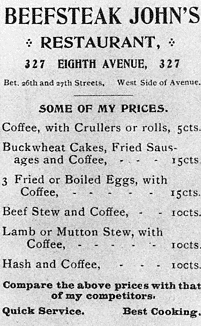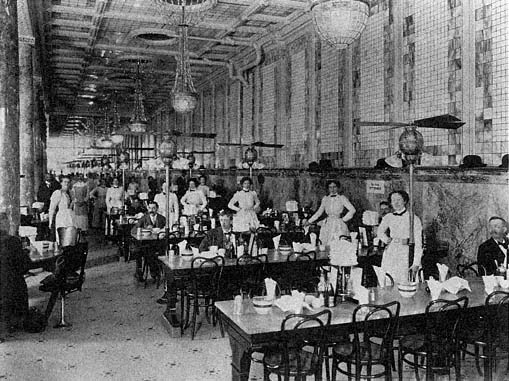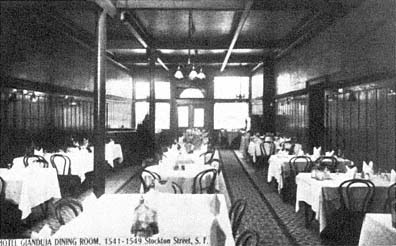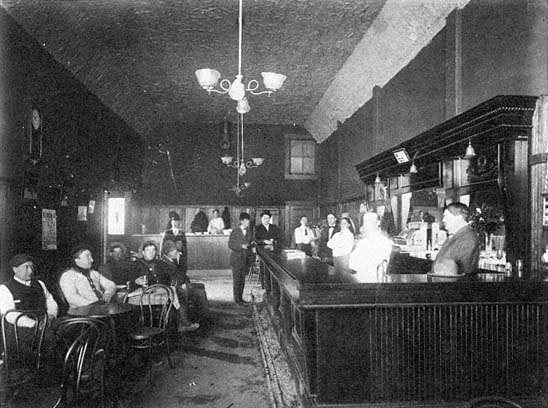Simple Food
On a day-to-day basis, the most important provision of the rooming house district was inexpensive food (fig. 4.19). Individualized dining was a major advantage of rooming houses over oldstyle boardinghouses. Boarders complained about eating at preset times, paying for meals whether they were there or not, not getting enough food, not having food they liked, and enduring very repetitious fare. While living in a rooming house, tenants could choose from a variety of places to eat, at varied prices, and over a much wider range of hours—provided payday was not too far away.[65]
The cheapest eateries were almost literally holes in the wall: tiny storefronts or basements, minimally adapted for their new uses. In Boston's South End in 1900, building owners converted house basements into small dining rooms managed, as Wolfe put it, by women "of uncertain experience." The atmosphere was dark, hot, and unfriendly. The beverage included with the meals could be either coffee or tea (one could not always be sure which it was, Wolfe said). However, the table d'hôte meals of four dishes cost as little as 20 cents each. Model boardinghouses run by home economists and settlement volunteers could not set a table at such low prices. At small storefront places in the industrial areas, the lunch fare was likely a cheap stew (potatoes,
Figure 4.19
Wallet card advertising a
beanery-style fast-food
emporium in New York City, 1901.
Figure 4.20
Child's Restaurant, a dairy lunchroom in New York City, ca. 1900.
carrots, and as little meat as possible) served with bread, pie, and coffee. Later, cafeterias and small counter-and-booth luncheonettes in rooming house areas continued the traditions of the small eateries. Through the 1960s, they remained a frequent haunt of rooming house residents.[66]
Larger basement restaurants offered similar bargains but better atmosphere. In the 1880s and 1890s, large and profitable places known as "three for two" restaurants catered to rooming house patrons, offering three 10-cent courses for two bits (25 cents). These eateries were a variation on the "beef and" restaurants, serving beans with a hefty cut of beef or pork, that sprang up after the Civil War.[67] Richardson, in the New York she knew during the late 1890s, occasionally treated herself with a good meal and a cup of hot coffee at a dairy lunchroom or quick lunchroom (fig. 4.20). Dairy lunchrooms were in large storefront spaces, attractively remodeled with white tile walls. They opened early and closed late. In some, tidy waitresses gave rapid service; in others, patrons picked up their food and ate at side-arm chairs. From a fairly large bill of fare, patrons could have a full dinner for 15 cents, order items à la carte for 5 to 7 cents, and efficiently pay the cashier in her cagelike desk.[68]
Meals in smaller new cafés were an even bigger treat for roomers who wanted a special dinner out. The range of Bohemian cafés in rooming house districts were typically known throughout the city for their informal dress, casual manners, and reasonable prices. Most cafés commanded a street view through plate glass windows and also had electric lights and fans. They were clean and attractive and had linen tablecloths. A steady café diet could cost $4.50 or $6 a week, as even spare breakfasts cost 20 cents; lunches, 25 cents; and dinners, 35 cents. Inexpensive hotel dining rooms essentially offered the same service (fig. 4.21).[69]
For convivial alternatives to the cafés, rooming house residents could turn to bars and saloons. Eating in a saloon was clearly working-class behavior and hence suspect for young people who aspired to the middle and upper class. Yet in 1912 a Philadelphia housing reformer defended the saloon with a positive description:
[Patrons at a saloon] could have a good dish of soup by purchasing a glass of beer for five cents. Often there is an egg, a clam, a fried oyster, or reed-bird
Figure 4.21
A small hotel's dining room. For rooming house residents, the Hotel Gianduja
in San Francisco's North Beach was a typical place for a special dinner.
given free with every drink. . . . For a very small price a hungry man can get as much as he cares to eat or drink. . . . As a rule the food is good, well-cooked, and palatable.[70]
Furthermore, he said, "That air of poverty which unfailingly pervades the cheap restaurants, and finds its expression in cheap and dirty table linen, is wanting in the saloon."[71] Polished oak or mission tables greeted saloon patrons (fig. 4.22). Richardson, too, was surprised one day when her fellow laundry workers whisked her through the women's entrance to a saloon. "Whatever the soup was made of, it seemed to me the best soup I had ever eaten in New York," she wrote, adding that she would "never again blame a working man or woman for dining in a saloon in preference to the more godly and respectable dairy-lunch room."[72] In the early 1900s, many saloons required that hungry patrons buy two beers to get the free lunch.
Other competitors to cheap cafés were illegal hot plates in one's room. Landladies often supplied these, to the concern of fire marshals. Regular diets of snack foods were available at the many neighborhood bakeries, delicatessens, grocery stores, and fruit stands. Their ready-to-eat bread, cake, cheese, and pickles supplemented the hot-plate fare.[73] Not only rooming house residents but also permanent guests at nearby midpriced hotels availed themselves of the delicatessen supplies.
In both the older, revamped neighborhoods like the Fillmore and the newer areas like the Tenderloin, the local dance halls and bars (or after
Figure 4.22
A plain saloon. After work hours, construction workers mix with young clerks in this San Francisco
saloon. Note the lunch counter at the rear.
Prohibition, the local lunch counters) often had a group of regular neighborhood customers. To the horror of her colleagues, the sociologist Margaret Chandler found a high degree of social cohesiveness in these groups. Social circles focused on one person's room or more frequently around a particular lunch counter, bar, or street corner. Some lunch stand groups behaved much as they might have in small towns. People stopped several times a day or night; on occasion, owners cooked up special meals for their regulars and extended them credit.[74] This social cohesion stood in sharp contrast to the alienation, anonymity, and illegal behavior that also characterized the mixtures of rooming house districts.



